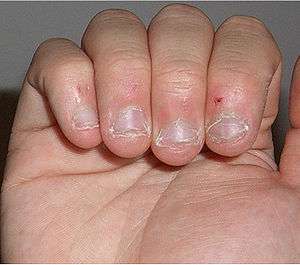Onychotillomania
| Onychotillomania | |
|---|---|
 | |
| The hands of a subject exhibiting the signs of the neurosis | |
| Classification and external resources | |
| Specialty | psychiatry |
| ICD-10 | F98.8 (ILDS F98.820) |
| DiseasesDB | 32039 |
Onychotillomania is a compulsive neurosis in which a person picks constantly at the nails or tries to tear them off.[1] It is not the same as onychophagia, where the nails are bitten or chewed or dermatillomania, where skin is bitten or scratched.
It is commonly associated with psychiatric disorders such as depressive neurosis, delusions of infestation[2] and hypochondriasis.[3]
It was named by Professor Jan Alkiewicz, a Polish dermatologist.[4]
The constant destruction of the nail bed leads to onychodystrophy, paronychia[5] and darkening of the nail.[6]
Some cases have been treated successfully with antipsychotics.[7]
One cheap solution suggested by researchers is to cover the proximal nail fold with a Cyanoacrylate glue. "The mechanism of action for improvement is probably related to the presence of an obstacle to picking."[8]
See also
References
- ↑ James, William; Berger, Timothy; Elston, Dirk (2005). Andrews' Diseases of the Skin: Clinical Dermatology. (10th ed.). Saunders. ISBN 0-7216-2921-0.
- ↑ Sait, Mohammed. Onychotillomania 2 Case Reports Dermatologica 1985;171:200-202 PMID 4076493
- ↑ Kim MH, Park HJ, Lee JY, Cho BK. Two Cases of Onychotillomania. Korean J Dermatol. ISSN 0494-4739 2006 Jul;44(7):855-857. Korean.
- ↑ Grzybowski A, Zaba R. Professor Jan Alkiewicz, MD, and his influence on 20th century dermatology and mycology. Clinics in Dermatology. 27(3):317-322. PMID 19368061
- ↑ Harth W, Gieler U, Kusnir D, Tausk F. Clinical Management of Psychodermatology p. 21 Berlin: Springer; 2009. ISBN 978-3-540-34718-7
- ↑ Baran R. Nail Biting and Picking as a Possible Cause of Longitudinal Melanonychia. Dermatologica. 1990;181(2):126-128. PMID 2242780
- ↑ Hamann K. Onychotillomania treated with pimozide (Orap). Acta Derm. Venereol. 1982;62(4):364-366. PMID 6183881
- ↑ Ring, DS (2010). "Inexpensive Solution for Habit-Tic Deformity". Arch Dermatol. 146 (11): 1222–1223.